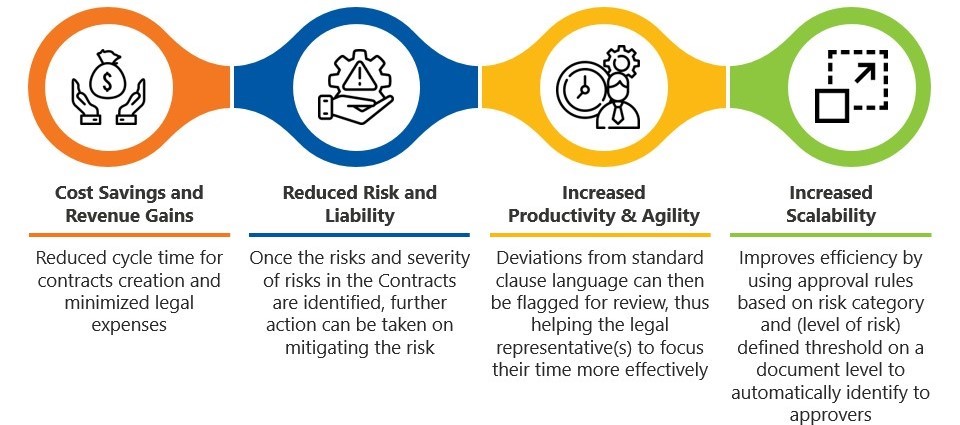
An In-Depth Guide to AI-Powered Contract Management
- Blog
- Contract Management
- Innovation
A study shows that the average Fortune 1000 company has an average of 40,000 active contracts on a given day.
Think about that for a second.
40,000 times that a contract needs to be authored, reviewed, negotiated, approved, and that’s just the beginning.
All contracts then need to be managed for their entire lifecycle, leveraging any negotiated clauses, monitored for compliance, and then reviewed again for renewal or amendments.
A single contract pulls in people from finance, legal and procurement, all needing to handle things manually.
This is time consuming and costly for one, but these manual and repetitive processes are very error prone which leads to further costs, missed deadlines, and compliance issues.
That’s just for one contract.
Another study shows that for a low-risk contract, the price of the traditional contract lifecycle management has risen to $6,900 and happens each time the contract needs to be renewed.
That doesn’t even take into account the higher risk contracts.
Multiply the time and costs of the process by 40,000 and you can really see the shortcomings of traditional contract lifecycle management.
However, now technologies like AI are making their way into the mainstream and having a powerful impact on the cost efficiency of contracts.
Check out these 6 companies and the value they’re driving with CLM
Procurement Contracts: The Foundation of Business Relationships
A procurement contract is one of the most important pieces in business. It outlines the relationship between a buyer and supplier in its entirety.
Want to know what suppliers you should use? It’s in a contract.
Want to know what the negotiated rates or price tiers are? It’s in a contract.
You get the idea. It spells out everything about how the buyer-supplier relationship will be executed across the entire contract lifecycle.
The Average Contract Management Lifecyle
An average contract’s lifecycle can be split into two distinct parts, pre-signature and post-signature, each coming with their own challenges and responsibilities.
Pre-signature:
Encompasses the initial authoring of a contract, negotiations, editing, and approvals. This is largely a cross-departmental undertaking, relying mostly on manual tasks and negotiations.
- Takes significant manual work, leading to delays and setbacks
- Risks and exceptions can be missed opening up to compliance issues, damaged relationships, and high costs or fees
- Departments with changing needs may need to call for a compete rework of contract sections leading to large costs and setbacks
- Manual processes aren’t scalable so when dealing with a large number of contracts, things get bottlenecked or rushed, leading to more errors and missed deadlines
Post-signature:
Deals with contract management and enforcement, along with the renewal and amendment process. This is ongoing throughout the entire length of the contract and details can easily be missed when dealing with a large volume of varyingly complex contracts.
- Typically done manually with the bulk of the burden falling upon procurement or finance.
- Complex contracts require a complex understanding of each detail to effectively manage, which isn’t realistic
- Impossible to get real time data into contract spend and savings opportunities
- Repetitive tasks prone to burnout and mistakes
- Missed deadlines due to manual communications and department overload
To make a long story short, traditional contract lifecycle management is far less than ideal.
Considering the number of contracts a typical organization deals with, the manual and repetitive nature of many tasks, and the overall lack of data and visibility into spend performance, costs and time waste can quickly get out of hand.
Innovation is at Your Doorstep
Artificial intelligence has already had a massive impact on everyday social life.
Smartphones run on AI, household budgeting apps combine AI and data visualization, depending on the model, even your thermostat runs on AI to become more efficient and convenient.
Now AI is becoming more mainstream in the business world, and soon, perhaps even as soon as 2025 according to Spend Matters, it will become intertwined in all our procurement processes.
But some of this technology is here today.
Siri for procurement? You got it.
Platforms that learn and adapt over time? Yeah, cognitive intelligence is here too.
If this is conjuring up scenes from The Terminator, it shouldn’t, quite the opposite in fact.
Instead, you should be celebrating – no more repetitive and manual tasks taking up your days.
Leveraging the Power of AI for Contract Management
Gartner predicts that the manual input involved in contract review will reduce by 50% in only four years thanks to AI.
They go on to say that over 60% of in-house legal work is repetitive and based on facts, meaning that it doesn’t need a human’s judgement.
This is just one example of something that AI can help to eliminate, cutting costs and opening the door for those legal professionals to focus on things that do take judgement and strategy.
We believe that AI is going to provide value in four key areas:
Cost Reduction:
AI provides the opportunity to cut costs in many different areas. One of which is to take the burden off people.
To make it clear, this is not to say that people aren’t needed, and AI should replace these jobs. But when a job can be done quicker, more efficiently, and with much less error by AI, it would be foolish not to explore that route.
A human’s judgment and leadership will always be needed in business. But the future of business will require people to learn new skills and shift their focus.
Ultimately this should lead to a more strategic and rewarding job, free of repetitive, ‘mindless’ tasks.
AI can also scan contracts to find risky clauses, unused credit limits, and allow you to find leverage or negotiate better rates.
Risk Management:
All contracts have inherent risks, at least to some degree. However, all the factors that play into these risks are constantly changing.
Different regional and global standards and regulations, changing business functionality, business stability, and simply the ability to meet the requirements that the contract has laid out.
Asking a single person, or even a team of people to thoroughly vet these factors takes time and isn’t always done accurately.
Instead, AI can perform an in-depth, constant analysis to flag exceptions for review, monitor risk factors, alert you of dynamic changes, and assigns a contract risk score for future reference. It can also provide out-of-the-box suggestions to replace risky clauses.
Agility and Scalability:
Organizational agility is typically tossed around as a buzzword, but it is an important aspect of a successful business.
When you break it down, agility comes down to adaptability and scalability.
You need to be able to do processes quickly, efficiently and error free. And you need to be able to adapt to changing requirement or market conditions quickly.
AI can cut down the contract process from ingestion, extraction, scoring, and digitization, all within 60 seconds.
This significantly reduces the time it takes in the procurement phase of the contract, all while keeping things error free.
At the same time the AI can scan the contract, pick out risky clauses, flag them for review, and allows for quicker changes to be made in the case of department or industry changes.
Visibility:
Arguably one of the best functions of AI in contract management is the enhanced visibility it provides.
Visibility is what allows you to cut costs, increase agility, and reduce risks.
AI provides powerful spend classification and analytics to offer insights for renegotiating contracts and using real time data to best leverage and manage your on contract spend.
You can set up vendor-specific dashboards to view each vendor’s strengths and vulnerabilities for better partner identification and renegotiation and get a 360° view of your supplier ecosystem.
Choosing the Right AI-Contract Management Solution For You
AI will have a profound impact on organizations globally. But that doesn’t need to be a distant dream.
The technology is here, now all that’s left is for all of you is embrace this change head on and pick the right technology partner to fit your needs.
This is an investment in your future, and you should take into account several important questions before making a decision.
Does it integrate with your systems easily? Is it flexible enough to fit your needs? Is it intuitive and easy to learn? Do you want access to a support team? How powerful are the analytical capabilities, and is it a secure platform?
AI can make your life easier, save you money, and give you insight to make improvements in areas you’ve never even considered before.





